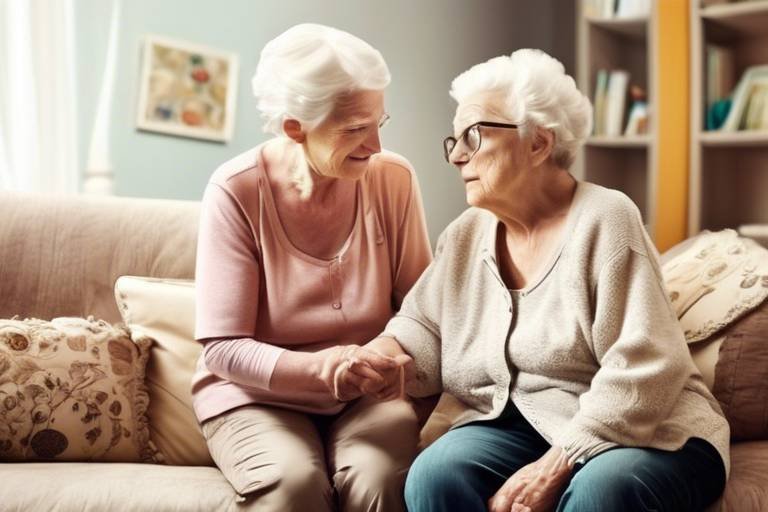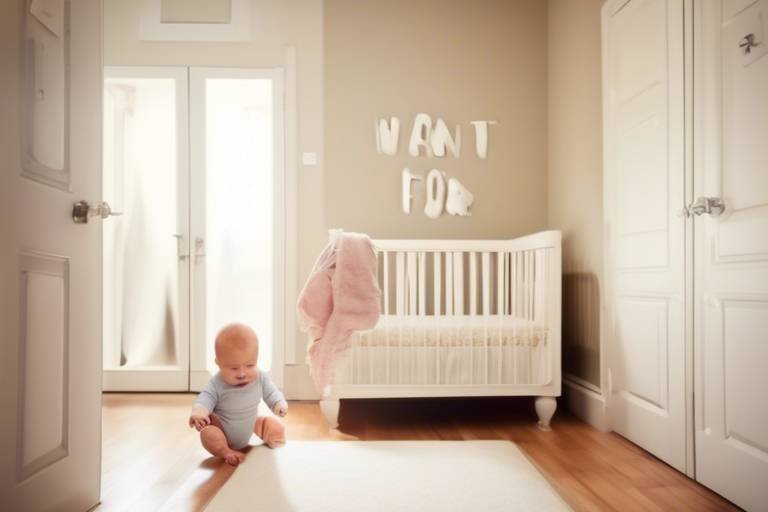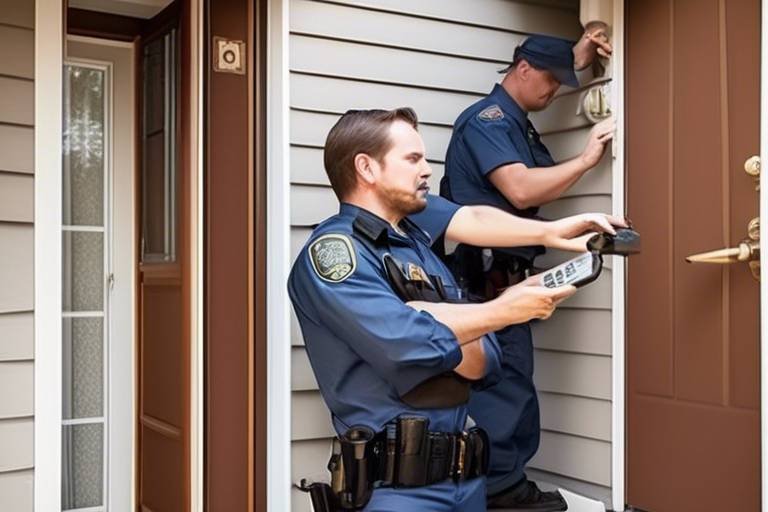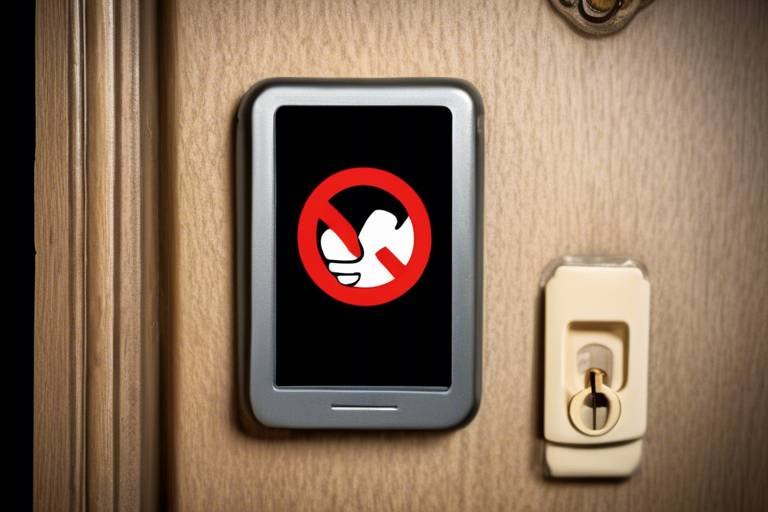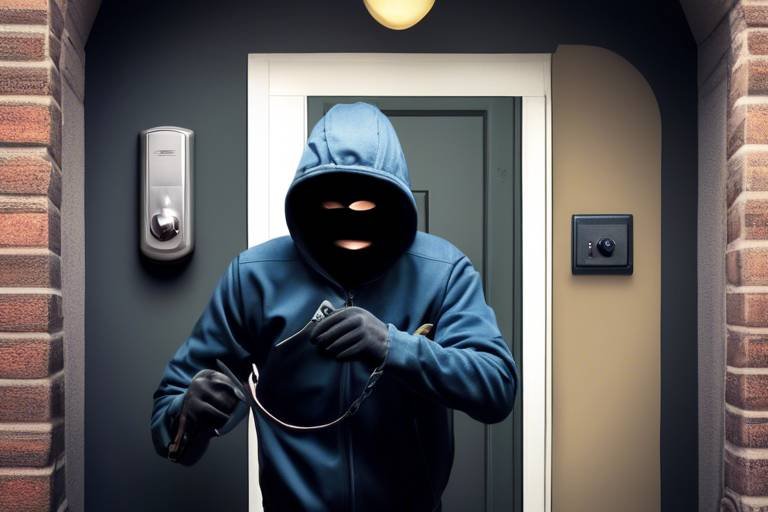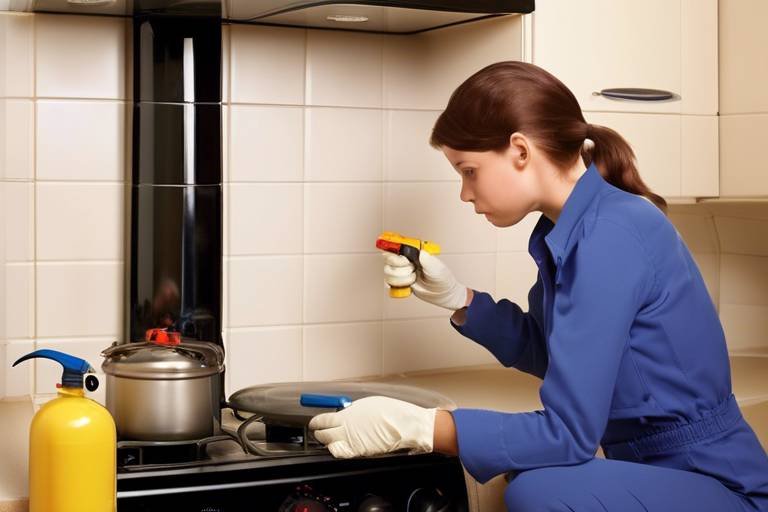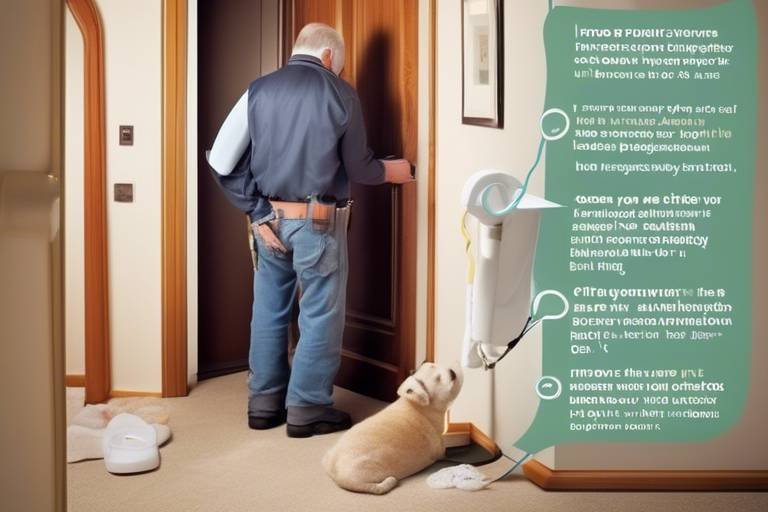Preparing Your Home for an Elderly Parent
As our loved ones age, the thought of bringing an elderly parent into our home can be both exciting and overwhelming. It’s a chance to provide them with the care and support they need while ensuring they maintain their independence. But how do you create a space that is not only comfortable but also safe? This article provides essential tips and considerations for creating a safe and comfortable living environment for elderly parents, ensuring their well-being and independence while living at home.
Evaluating your home's layout is crucial for accommodating an elderly parent. Imagine navigating through your home with limited mobility—it's not just about getting from point A to point B. You need to think about mobility challenges and make necessary adjustments to ensure easy navigation throughout the space. Start by walking through your home and identifying potential obstacles. Are there narrow hallways? Are rugs or furniture in the way? Consider removing or rearranging items that could pose a risk. The goal is to create a flow that allows for easy movement, making it a welcoming environment for your parent.
Implementing safety modifications can significantly reduce risks for elderly parents. Simple changes, like installing grab bars and removing tripping hazards, can create a safer living environment. Think of your home as a sanctuary—a place where your parent can feel secure. Here are some modifications to consider:
- Grab bars: These should be installed in the bathroom, near the toilet, and in the shower to provide support.
- Non-slip mats: Place these in the bathroom and kitchen to prevent falls.
- Clear pathways: Ensure that hallways and rooms are free from clutter and obstacles.
The bathroom can be particularly hazardous for seniors. Installing non-slip mats, raised toilet seats, and handheld shower heads can enhance safety and accessibility in this space. Consider a walk-in shower with a bench, which can make bathing much easier and safer. By transforming the bathroom into a more user-friendly area, you provide peace of mind for both you and your parent.
Proper lighting is essential for preventing falls. Ensure all rooms, especially hallways and staircases, are well-lit. Think about adding motion-sensor lights that automatically turn on when someone enters a room. This simple addition can make a world of difference, especially during the night when visibility is low. Remember, a well-lit home not only enhances safety but also creates a warm and inviting atmosphere.
Establishing an emergency plan is vital for elderly parents. It's not just about having a first aid kit; it's about being prepared for various situations. Discuss procedures for medical emergencies and ensure easy access to emergency contacts. Consider creating a list of important phone numbers, including family members, doctors, and local emergency services. This way, your parent can quickly reach out for help if needed.
The kitchen should be user-friendly for elderly parents. Rearranging frequently used items within easy reach and using adaptive tools can promote independence and safety while cooking. Imagine your parent trying to reach for a pot on a high shelf—it's not just inconvenient; it can be dangerous. Keep essentials like utensils, pots, and spices at waist level to make cooking a breeze. Additionally, consider using lightweight cookware to make meal preparation less strenuous.
Incorporating communication and monitoring systems can enhance safety and peace of mind. Imagine your parent being able to call for help with just the press of a button. Consider using medical alert systems and smart home technology for easy access to assistance. Devices like smart speakers can also help them stay connected with family and friends, reducing feelings of isolation.
Technology can empower elderly parents to maintain independence. Devices like voice-activated assistants and smart home features can simplify daily tasks and improve their quality of life. For instance, they can set reminders for medications or control the lights with their voice. This not only fosters independence but also makes daily living more manageable.
Encouraging regular health check-ups is essential for elderly parents. Staying on top of medical appointments can help manage health conditions and ensure timely interventions when needed. Consider creating a calendar that tracks appointments, medications, and any necessary follow-ups. This proactive approach can significantly improve their overall health and well-being.
Q: What are the most important safety modifications to make in my home?
A: Start with grab bars in the bathroom, non-slip mats, and ensuring clear pathways throughout the home.
Q: How can I encourage my elderly parent to maintain their independence?
A: Rearranging the kitchen for easy access, using adaptive tools, and incorporating technology can help them feel more independent.
Q: What should I include in an emergency plan?
A: Include important phone numbers, medical information, and procedures for various emergencies.

Assessing Your Home's Layout
When it comes to preparing your home for an elderly parent, one of the first steps is to thoroughly assess your home's layout. This is not just about aesthetics; it's about creating a space that enhances mobility and accessibility. You might be surprised at how many small adjustments can make a world of difference in ensuring your elderly parent can navigate their surroundings with ease.
Start by walking through your home as if you were in their shoes. Are there any potential mobility challenges that could pose risks? For instance, narrow hallways, steep stairs, or cluttered spaces can be significant obstacles. You might think, "Oh, it's just a few steps," but for someone with limited mobility, those steps can feel like a mountain. Consider the following:
- Doorways: Ensure that all doorways are wide enough to accommodate walkers or wheelchairs.
- Flooring: Check for uneven surfaces or loose rugs that might cause trips.
- Furniture Arrangement: Rearrange furniture to create clear pathways that are easy to navigate.
Next, think about the rooms that are most frequently used. The kitchen, bathroom, and living areas should be particularly welcoming and easy to maneuver in. If your parent enjoys cooking, ensure that items they use often are within easy reach. You don't want them to have to stretch or bend too much, which could lead to accidents. You might even consider installing pull-out shelves or lazy Susans to make accessing items easier.
Another vital aspect of assessing your home's layout is considering the lighting. Poor lighting can turn even the simplest tasks into daunting challenges. Make sure that all areas, especially those prone to accidents like staircases and hallways, are well-lit. Adding motion-sensor lights can be a game changer—they turn on automatically when someone approaches, reducing the risk of falls in dimly lit areas.
Lastly, don't forget about emergency exits. In the event of a fire or other emergencies, it's crucial that your elderly parent knows how to get out quickly and safely. Make sure that exits are easily accessible and that they are aware of the fastest routes. You might even consider conducting a little practice run to ensure they feel confident in an emergency situation.
In summary, assessing your home's layout is about more than just making things look nice; it’s about creating a safe and comfortable environment that promotes independence and well-being for your elderly parent. Remember, small changes can lead to significant improvements in their daily life.

Safety Modifications
When it comes to ensuring the safety of your elderly parent at home, making safety modifications is not just a good idea; it’s essential. As we age, our physical capabilities can change, and what was once a simple task can become a challenge. Therefore, it’s important to assess your home and make necessary adjustments that can significantly reduce the risk of accidents. Imagine your home as a cozy fortress, where every corner is designed to promote comfort and security. By implementing the right modifications, you can transform your living space into a haven for your loved one.
One of the most impactful changes you can make is to address tripping hazards. These can include loose rugs, clutter, or even uneven flooring. Consider securing rugs with non-slip pads and keeping walkways clear. Additionally, it’s wise to evaluate the furniture arrangement. Ensure that there is enough space for easy navigation, especially if your parent uses a walker or a wheelchair. This simple act can make a world of difference in preventing falls.
Furthermore, installing grab bars in key areas such as the bathroom and along stairways can provide much-needed support. These bars act as a safety net, allowing your parent to maintain their balance while moving around. It’s like having an extra hand to hold onto when navigating tricky spots. In addition, consider using non-slip mats in the bathroom to prevent slips and falls, which are unfortunately common in this area of the house.
Speaking of the bathroom, it’s important to think about the fixtures as well. Raised toilet seats can make it easier for seniors to sit and stand, while handheld shower heads can provide greater control and reduce the risk of falling. These modifications not only enhance safety but also promote independence, allowing your parent to maintain their personal hygiene with dignity.
Let’s not overlook the importance of lighting. Proper illumination is crucial for preventing falls. Ensure that all rooms, especially hallways and staircases, are well-lit. Consider installing motion-sensor lights that turn on automatically when someone enters a room. This small change can eliminate the need for your parent to fumble for light switches in the dark, which can be dangerous. Think of it as creating a welcoming path of light that guides them safely throughout the home.
Another critical aspect of safety is having an emergency plan in place. Discuss procedures with your elderly parent for various situations, including medical emergencies. Make sure they know how to reach emergency contacts quickly. You might even consider creating a list of important numbers and placing it in a visible location, like on the refrigerator. This way, in a moment of panic, they can easily access the information they need.
In conclusion, safety modifications in the home are vital for the well-being of elderly parents. By addressing potential hazards and making thoughtful changes, you can create an environment that not only protects but also empowers them to live independently. Remember, every small change counts towards building a safer living space that fosters comfort and confidence.
- What are the most common safety modifications for elderly parents? Common modifications include installing grab bars, removing tripping hazards, improving lighting, and adding non-slip mats.
- How can I make my bathroom safer for an elderly parent? Consider using raised toilet seats, non-slip mats, and handheld shower heads to enhance safety and accessibility.
- Why is lighting important for elderly safety? Proper lighting helps prevent falls and allows seniors to navigate their home safely, especially during the night.
- What should be included in an emergency plan for elderly parents? An emergency plan should include procedures for medical emergencies, a list of important contacts, and easy access to emergency numbers.

Bathroom Safety Enhancements
When it comes to creating a safe haven for your elderly parent, the bathroom is often the most overlooked area. This space, while essential for daily routines, can also be a hotspot for accidents. Imagine stepping out of a warm shower onto a slippery floor—it's a recipe for disaster! That's why implementing is not just a good idea; it's a necessity.
One of the first modifications to consider is the installation of grab bars. These sturdy fixtures provide support when getting in and out of the shower or using the toilet. They can be strategically placed near the shower, bathtub, and toilet to offer stability at crucial moments. Think of them as a lifeline, giving your parent the confidence to navigate this slippery space.
Another critical enhancement is the addition of non-slip mats or strips. These can be placed both inside and outside the shower or bathtub to prevent any slips. It's surprising how something so simple can make such a big difference! Additionally, consider using a raised toilet seat. This feature can alleviate strain on joints and make it easier for your parent to sit down and stand up. It’s like giving them a little boost every time they use the restroom.
Accessibility is key, and that’s where handheld shower heads come into play. These allow for easier bathing, enabling your parent to sit while showering without compromising cleanliness. This small change can transform the bathing experience, making it both safer and more enjoyable. Also, think about installing a shower chair or bench. This provides a safe place to sit while showering, reducing the risk of falls and allowing for a more relaxed bathing experience.
Lighting is another crucial element that shouldn't be ignored. Ensure that the bathroom is well-lit, especially around the shower and toilet areas. Consider adding motion-sensor lights that automatically turn on when someone enters the room. This way, even in the middle of the night, your parent won’t have to fumble around in the dark, which can lead to accidents.
Lastly, it’s essential to have a clear plan in case of emergencies. Make sure your parent knows how to reach out for help if they do fall or have an accident. You might even consider installing an emergency call button within reach of the toilet or shower. This simple addition can provide peace of mind, knowing that help is just a button press away.
By taking these bathroom safety enhancements into account, you are not just making modifications; you are creating an environment where your elderly parent can feel secure and independent. It’s all about fostering a sense of dignity and comfort in their daily life.
- What are the most important bathroom safety features? Grab bars, non-slip mats, and proper lighting are crucial for preventing accidents.
- How can I make the bathroom more accessible? Consider installing a raised toilet seat, handheld shower heads, and a shower chair.
- Are there any emergency measures I should implement? Yes, having an emergency call button and ensuring easy access to help is vital.

Lighting Improvements
When it comes to creating a safe haven for your elderly parent, are often an overlooked yet critical aspect. Think about it: poor lighting can easily turn a simple trip to the bathroom into a perilous expedition. It’s essential to ensure that every corner of the home is well-lit, especially areas with high foot traffic like hallways, staircases, and entrances. Imagine walking in a dimly lit room; even the most agile person can misjudge a step. Now, consider someone with mobility challenges—this could lead to serious injuries.
One effective way to enhance lighting is by installing motion-sensor lights. These nifty devices automatically turn on when someone enters a room, providing illumination without the need to fumble for a switch. This not only adds convenience but also reduces the risk of falls in those critical moments when your parent needs to navigate through the house at night. Additionally, consider using brighter bulbs in existing fixtures. A well-lit space can create a sense of security and comfort, making it easier for your loved one to move around.
Furthermore, it’s not just about the brightness; the type of lighting matters too. Soft, warm lights are generally more inviting and can help create a cozy atmosphere, whereas harsh, bright lights can be jarring. Think about incorporating task lighting in specific areas, like the kitchen and reading nooks, where your parent might need concentrated light. For instance, under-cabinet lights in the kitchen can illuminate countertops, making food preparation safer and more enjoyable.
Lastly, don’t forget about the importance of natural light. If possible, keep curtains or blinds open during the day to let sunlight flood in. Natural light not only brightens up a space but also has been shown to improve mood and well-being. However, be mindful of glare and consider using sheer curtains that diffuse sunlight while still allowing it to shine through. By making these thoughtful lighting improvements, you can dramatically enhance the safety and comfort of your home for your elderly parent.

Emergency Preparedness
When it comes to ensuring the safety of your elderly parent, is not just a good idea—it's a necessity. Imagine a scenario where a minor accident occurs, and your loved one is unable to reach out for help. This is where having a solid emergency plan becomes invaluable. Start by having a candid conversation with your parent about various emergency situations they might face, such as medical emergencies, natural disasters, or even simple household accidents.
Creating a comprehensive plan involves several key steps. First, you should compile a list of important contacts, including family members, friends, and medical professionals. Make sure this list is easily accessible, perhaps on the fridge or in a dedicated emergency binder. You might even consider using a smartphone app to keep all this information organized and readily available.
In addition to contact lists, it’s crucial to establish clear procedures for different emergencies. For instance, what should your parent do if they fall and can’t get up? Discuss the importance of using medical alert systems, which can provide immediate assistance with just the push of a button. These devices can be lifesavers, offering peace of mind not just for your parent, but for you as well.
Another important aspect of emergency preparedness is planning for natural disasters. Depending on your location, you may need to prepare for hurricanes, earthquakes, or severe storms. Create a simple emergency kit that includes essentials like water, non-perishable food, medications, and a flashlight. Regularly check and update this kit to ensure everything is in working order and not expired.
Lastly, consider conducting regular drills. Much like fire drills in schools, these can help your elderly parent feel more confident and prepared for real-life emergencies. Whether it’s practicing how to use a medical alert system or reviewing the steps to take in a natural disaster, these drills can make a significant difference in their response during an actual emergency.
In summary, being prepared for emergencies is all about creating a safety net that allows your elderly parent to feel secure and independent. By having open conversations, establishing procedures, and regularly reviewing plans, you can ensure that they are not only ready for emergencies but also feel empowered to handle them.
- What should be included in an emergency kit for seniors?
An emergency kit for seniors should include water, non-perishable food, medications, a flashlight, batteries, a first-aid kit, and important documents.
- How can I help my elderly parent feel more secure at home?
Implementing safety modifications, ensuring proper lighting, and establishing a communication system can help your elderly parent feel more secure.
- What are the benefits of using a medical alert system?
A medical alert system provides instant access to help, allowing seniors to call for assistance in emergencies, which can be crucial for their safety.

Kitchen Modifications
The kitchen is often considered the heart of the home, but when it comes to accommodating an elderly parent, it can also become a challenging space. The goal here is to create a user-friendly environment that promotes independence while ensuring safety. Imagine trying to cook a meal while struggling to reach for a pot on a high shelf or navigating around cluttered countertops—frustrating, right? By making a few thoughtful modifications, you can transform the kitchen into a haven of comfort and accessibility.
Start by rearranging the kitchen layout. Place frequently used items, such as pots, pans, and utensils, within easy reach. This not only minimizes the risk of falls but also makes cooking a more enjoyable experience. Consider using pull-out shelves or lazy Susans in cabinets to make items more accessible without the need to bend or stretch. Additionally, using adaptive tools like ergonomic utensils can make a world of difference. These tools are designed to be easier to grip and manipulate, making meal preparation less of a chore.
Another critical aspect of kitchen modifications is ensuring that the space is free from tripping hazards. Keep floors clear of clutter and consider using non-slip mats in areas where spills are likely to occur. If your parent enjoys cooking, installing a lowered countertop can provide a more comfortable workspace. This adjustment allows them to work at a height that doesn't strain their back or arms, promoting a more enjoyable cooking experience.
Lighting also plays a vital role in kitchen safety. Adequate lighting can help prevent accidents and make it easier to see what they're doing while cooking. Consider installing under-cabinet lighting to illuminate work surfaces and ensure that all areas of the kitchen are well-lit. This small change can significantly enhance visibility and reduce the risk of mishaps.
Lastly, don't underestimate the power of organization. A well-organized kitchen can reduce stress and confusion. Consider using labeled containers for dry goods and utensils, which can help your elderly parent quickly find what they need without rummaging through drawers. This simple step not only promotes independence but also instills a sense of pride in their ability to manage their own cooking.
In summary, modifying the kitchen for an elderly parent involves thoughtful rearrangement, safety enhancements, and organization. By creating a space that is both functional and inviting, you can help your loved one maintain their independence while ensuring their safety and comfort in the kitchen.
- What are the essential modifications needed in a kitchen for elderly parents?
Essential modifications include rearranging frequently used items for easy access, using adaptive tools, ensuring good lighting, and eliminating tripping hazards. - How can I make the kitchen more accessible?
Consider installing pull-out shelves, using non-slip mats, and keeping floors clear of clutter to enhance accessibility. - Are there specific tools recommended for elderly individuals?
Yes, ergonomic utensils and tools designed for easy gripping can significantly aid in meal preparation.

Communication and Monitoring Systems
In today's fast-paced world, ensuring the safety and well-being of our elderly parents is more critical than ever. One of the best ways to achieve this is by incorporating into their daily lives. These systems not only provide peace of mind for both the elderly and their families but also empower seniors to live independently, knowing help is just a button press away. Imagine a scenario where your parent can call for assistance without struggling to reach a phone or feeling isolated in their home; that’s the magic of modern technology!
When considering communication options, think about the various devices available that can facilitate easy interaction. For instance, medical alert systems are incredibly popular and can be lifesavers in emergencies. These devices often come with a pendant or wristband that allows seniors to alert emergency services or family members with just a push of a button. Many systems even offer fall detection features, which can automatically notify caregivers if a fall is detected. Here’s a quick comparison of some popular medical alert systems:
| System | Features | Monthly Cost |
|---|---|---|
| Life Alert | 24/7 monitoring, fall detection, mobile option | $49.95 |
| Medical Guardian | GPS tracking, no long-term contracts, water-resistant | $29.95 |
| Bay Alarm Medical | Home and mobile options, fall detection, free equipment | $19.95 |
In addition to medical alert systems, integrating smart home technology can significantly enhance communication and monitoring. Smart speakers, such as Amazon Echo or Google Home, can act as a hub for various devices. With voice commands, your parent can control lights, thermostats, and even make calls to family members. This technology not only makes life easier but also reduces the risks associated with mobility issues.
Furthermore, consider utilizing video calling applications like Zoom or FaceTime. These platforms allow for face-to-face interaction, which can combat feelings of loneliness and isolation. Regular video calls can help maintain strong family connections and provide emotional support. Just think about how uplifting it can be for your parent to see their grandkids' faces, even if it's through a screen!
Monitoring systems can also play a vital role in ensuring safety. Devices like motion sensors and smart cameras can alert you to unusual activity in the home. For example, if a sensor detects movement when it shouldn’t, you can check in on your parent to ensure everything is okay. These systems can be integrated into a smartphone app, allowing you to monitor your parent's well-being from anywhere, providing an extra layer of reassurance.
Ultimately, the goal of integrating is to foster independence while ensuring safety. By leveraging technology, we can create a supportive environment that allows our elderly parents to live comfortably at home. It's about striking a balance—giving them the freedom they desire while also providing the security they need. So, why not explore these options and see how they can transform the living experience for your loved ones?
- What is a medical alert system? A medical alert system is a device that allows seniors to call for help in emergencies, typically with the press of a button.
- How can smart home technology benefit elderly parents? Smart home technology can simplify daily tasks, enhance safety, and improve communication with family members.
- Are video calls beneficial for seniors? Yes, video calls can help reduce feelings of loneliness and isolation by maintaining family connections.

Technology for Independence
In today's fast-paced world, technology plays a pivotal role in enhancing the quality of life for our elderly parents. Imagine a scenario where your loved one can manage daily tasks with ease, thanks to innovative gadgets and smart home systems. It's not just about convenience; it’s about empowering them to maintain their independence while ensuring their safety. With the right technology, you can transform their living space into a haven of comfort and security.
One of the most significant advancements has been the development of voice-activated assistants. Devices like Amazon's Alexa or Google Home can assist elderly parents in numerous ways. They can set reminders for medications, control smart devices, and even make phone calls—all with simple voice commands. This not only simplifies their daily routines but also reduces the frustration that can come with using traditional technology.
Furthermore, smart home technology can be a game-changer. Imagine a home where lights turn on automatically when someone enters a room or where the thermostat adjusts itself based on the time of day. These features can enhance comfort and safety, making it easier for elderly parents to navigate their homes without the fear of stumbling in the dark. For instance, motion-sensor lights placed along hallways or staircases can illuminate paths, significantly reducing the risk of falls.
Additionally, medical alert systems are indispensable for elderly individuals living alone. These systems allow them to call for help at the touch of a button, providing peace of mind not just for them but also for their families. Many modern systems even come with fall detection technology, which can automatically alert emergency services if a fall is detected. This feature is crucial, especially for seniors who may not be able to reach their phones in an emergency.
Another exciting area is the use of wearable technology. Devices like smartwatches can monitor vital signs such as heart rate and activity levels, and some even have built-in fall detection. These wearables can provide valuable insights into their health and can alert caregivers if something seems off. This proactive approach to health management can lead to earlier interventions and better health outcomes.
To make the most out of these technologies, it's essential to involve your elderly parent in the selection process. Discuss their needs and preferences, and ensure they feel comfortable using the devices. After all, technology should serve as a tool for empowerment, not a source of frustration. When they feel confident in using these tools, it not only boosts their independence but also enhances their overall well-being.
In summary, integrating technology into the lives of elderly parents can dramatically improve their quality of life. From voice-activated assistants to smart home features and medical alert systems, the possibilities are endless. By embracing these innovations, we can ensure our loved ones enjoy their golden years with dignity and independence.
- What types of technology can help seniors live independently? Voice-activated assistants, medical alert systems, smart home devices, and wearable technology are all great options.
- How can I ensure my elderly parent is comfortable with new technology? Involve them in the selection process, provide training, and choose user-friendly devices that cater to their needs.
- Are there any specific features to look for in medical alert systems? Look for fall detection, easy-to-use buttons, and 24/7 monitoring services to ensure safety.
- Can smart home technology really reduce the risk of falls? Yes, features like motion-sensor lights and automated systems can significantly enhance safety by providing better visibility and reducing hazards.

Regular Health Check-ups
When it comes to the well-being of our elderly parents, play a crucial role. Think of these appointments as the maintenance checks for a beloved vehicle; just as you wouldn’t want your car to break down unexpectedly, you certainly don’t want your parent’s health to take a sudden turn for the worse. By keeping up with routine check-ups, you can catch potential health issues early, allowing for timely interventions that can make all the difference.
Encouraging your elderly parent to attend their scheduled appointments can be a challenge. Sometimes, they may feel overwhelmed by the healthcare system or simply forget the importance of these visits. To make it easier, consider creating a health calendar that outlines all upcoming appointments, tests, and necessary medications. You can even set reminders on their phone or use a family calendar app to keep everyone in the loop. This way, they won't feel alone in managing their health, and it will also help to reduce any anxiety they might have about going to the doctor.
Here’s a quick overview of some essential aspects to keep in mind regarding regular check-ups:
| Check-up Type | Frequency | Purpose |
|---|---|---|
| General Health Assessment | Annually | To monitor overall health and detect any changes. |
| Blood Pressure Check | Every 6 months | To manage hypertension and cardiovascular health. |
| Cholesterol Screening | Annually | To assess heart disease risk. |
| Diabetes Screening | Annually | To monitor blood sugar levels and manage diabetes. |
| Vision and Hearing Tests | Every 1-2 years | To ensure sensory health is maintained. |
By keeping track of these appointments, you can help your elderly parent stay ahead of any potential health issues. It’s also vital to encourage open communication with their healthcare provider. If your parent has concerns or experiences new symptoms, they should feel comfortable discussing these with their doctor. This proactive approach can lead to better health outcomes and a greater sense of control over their well-being.
Lastly, don't forget the importance of mental health. Regular check-ups should include discussions about emotional well-being. Seniors can often feel isolated or depressed, especially if they have lost friends or loved ones. Encouraging them to speak with a mental health professional can be just as important as their physical health appointments. After all, a healthy mind is just as essential as a healthy body!
- How often should my elderly parent have health check-ups? It’s generally recommended that seniors have a comprehensive health assessment at least once a year, but some tests may need to be done more frequently depending on their health status.
- What should I do if my parent refuses to go to the doctor? Start by having an open conversation about their concerns. Sometimes, offering to accompany them can ease their anxiety and make the experience less daunting.
- Are there any specific tests my elderly parent should prioritize? Yes, routine screenings for blood pressure, cholesterol, diabetes, and cognitive health are important. Discussing these with their healthcare provider can help tailor a plan that fits their needs.
Frequently Asked Questions
- What are some essential modifications for a safe home environment for elderly parents?
Creating a safe home for your elderly parent involves several modifications. Start by assessing the layout of your home to ensure easy navigation. Implement safety features like grab bars in bathrooms, removing tripping hazards, and ensuring that all areas are well-lit. These changes can significantly reduce the risk of falls and accidents.
- How can I enhance bathroom safety for my elderly parent?
The bathroom can be particularly tricky for seniors. To enhance safety, consider installing non-slip mats, raised toilet seats, and handheld shower heads. These additions make it easier for your parent to use the bathroom safely and comfortably, reducing the risk of slips and falls.
- What lighting improvements should I make in my home?
Proper lighting is crucial for preventing falls. Make sure that all rooms, especially hallways and staircases, are well-lit. You might also want to consider adding motion-sensor lights that turn on automatically when someone enters a room. This small change can greatly enhance safety and convenience.
- How can I prepare for emergencies involving my elderly parent?
Establishing an emergency plan is vital. Discuss various emergency scenarios with your parent and ensure they know what to do in case of a medical emergency. Keep emergency contacts easily accessible, and consider having a medical alert system in place for immediate help.
- What kitchen modifications can promote independence for elderly parents?
To make the kitchen user-friendly, rearrange frequently used items so they are within easy reach. Consider using adaptive tools, such as easy-grip utensils and non-slip mats, to make cooking safer and more manageable. These changes can help your parent maintain their independence while preparing meals.
- How can technology assist elderly parents in their daily lives?
Technology can be a game-changer for elderly parents. Devices like voice-activated assistants can help them control their environment, set reminders for medications, or even make phone calls without needing to get up. Smart home features can also simplify daily tasks, enhancing their quality of life and promoting independence.
- Why are regular health check-ups important for elderly parents?
Encouraging regular health check-ups is essential for managing health conditions in elderly parents. These appointments help monitor their health status and ensure timely interventions when needed. Staying proactive about their health can lead to better outcomes and a higher quality of life.

